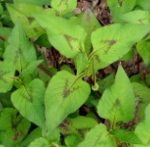
Unlike damage from pests and diseases, weeds can cause substantial yield loss in a crop without any apparent symptoms. For example, investigations carried out in Bhutan in 1991 across a wide range of locations reported average potato yields of 6.7, 10.7 and 11.6 t/ha for the treatments no weeding, farmers weeding and completely weed free, respectively. Based on these results, weed competition is reducing yields by an average of 42%.
Integrated weed management is therefore critical when growing all crops, to maximise yield and quality and to maximise the benefits of available water and nutrients.
There are also several important invasive weeds in Bhutan that need to be specifically managed – see below for more information.
Weeds of Bhutan
Published in 1992, Weeds of Bhutan is the result of the first extensive weed survey in Bhutan. 187 species are illustrated. They are mostly weeds of annual and perennial crops, but also includes some parasitic weeds of forestry and some wild plants likely to be poisonous to livestock. Although it includes weeds from throughout Bhutan, the highlands were better surveyed than were lowlands.
NPPC is currently reprinting this essential resource on weeds in Bhutan. A second edition with information on additional weeds is in the planning stage.
Agricultural Weeds
Other Resources
There is currently no information available for this topic.









